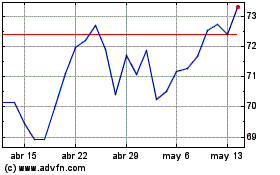New MetLife Study: Majority of Plan Sponsors Concerned about the Impact of Market Volatility on Near-Retirees and Retirees
23 Julio 2024 - 8:00AM
Business Wire
As macroeconomic uncertainty continues, the impact of market
volatility is a key consideration for today’s workforce and
retirees as they manage their retirement savings. Plan sponsors
recognize this and share their concern as MetLife’s Stable Value
Study, launched today, finds 69% of plan sponsors are concerned
about the impact of market volatility on those within 10 years of
retirement and 61% are concerned about the impact on retirees.
Stable Value funds are a capital preservation option designed
specifically for, and available only within, qualified defined
contribution (DC) plans and offer safety and stability for both
plan participants and retirees.
“Stable Value has a nearly 50-year history as a capital
preservation option in DC plans and provides protection against
market volatility in uncertain environments,” says Tom Schuster,
senior vice president and head of Stable Value and Investment
Products with MetLife. “This is essential for those participants
near or at retirement looking for earnings stability and liquidity,
along with a guarantee of principal and interest.”
Stable Value: A DC Plan Mainstay
Stable Value remains a popular capital preservation option among
plans sponsors, with 82% of DC plan sponsors currently offering
these funds. The Study found that the large majority of plan
sponsors (87%) have offered stable value for more than a year, and
66% have offered this solution for at least three years.
Eighty-four percent of plan sponsors say stable value was
recommended by their DC plan’s investment or financial advisor.
Eight in 10 advisors (76%) say the top reason for recommending
stable value is that it historically offers better returns than
money market or other capital preservation options.
“Plan sponsors and advisors recognize and appreciate stable
value’s long-term historical performance across all market cycles,”
says Schuster. “Because of this compelling track record, stable
value remains a popular choice and its outlook is strong.”
According to the Study, a majority of plan sponsors and advisors
(83% and 84%, respectively) view stable value as a good capital
preservation option for their plans because of its long-term
historical performance versus money market funds. An overwhelming
majority of plan sponsors, 95%, and advisors, 92%, say stable value
funds are valuable to participants seeking a safe haven, especially
those who are interested in maintaining their principal.
Stable Value and Target Date Funds
As target date funds (TDFs) remain popular within DC plans, a
critical consideration is whether participant savings in these
funds are adequately protected from market volatility. The Study
found that more than a third of plan sponsors, 37%, are considering
adopting strategies to manage volatility but only 12% of plan
sponsors to date have implemented these strategies, which may range
from the diversification of asset classes to the addition of
investment options.
“The good news is that there are new solutions available in the
market that apply the volatility smoothing principles of stable
value to TDFs,” says Warren Howe, national director, Stable Value
Markets. “These solutions allow plan sponsors to optimize the
risk/return profile of their TDFs by either lowering volatility
while maintaining returns or enhancing returns while maintaining
volatility.”
When presented with an example of the first approach—the TDF
provider delivers comparable returns, net of fees, while reducing
volatility by approximately 40% for certain vintages—the Study
found that 95% of plan sponsors would be interested in this option,
with 97% of advisors expressing interest. Plan sponsors and
advisors were also presented with a second option—the TDF provider
generates net returns four times more than the cost associated with
delivering those incremental returns while keeping volatility
constant (e.g., 60 basis points enhanced net returns for a cost of
15 basis points). The Study found 94% of plan sponsors would be
interested in this option while 95% of advisors are interested.
“Plan sponsors can apply these strategies to custom TDFs to
reduce the fund’s volatility, particularly for participants who are
near or in retirement,” says Howe. “By doing so, they can create
better retirement outcomes.”
About the Study
MetLife commissioned Greenwald Research to conduct surveys of
plan sponsors and advisors between February 26 and March 21, 2024.
A total of 238 interviews were completed among plan sponsors who
offer a 401(k), 457 or 403(b) plan. Assets under management for
plans included in the study ranged from under $10 million to over
$1 billion. Each respondent had to work for a company that offers a
DC plan with TDFs or target risk options, offer a capital
preservation option, and have at least a moderate amount of
influence over decisions regarding stable value or related funds
for their company’s DC plan(s). Online surveys were also completed
by 50 DC plan advisors who have worked as a plan advisor for at
least three years and have clients with DC plans that currently
offer capital preservation options. To read the full report, visit
http://metlife.com/svstudy2024.
About MetLife
MetLife, Inc. (NYSE: MET), through its subsidiaries and
affiliates (“MetLife”), is one of the world’s leading financial
services companies, providing insurance, annuities, employee
benefits and asset management to help individual and institutional
customers build a more confident future. Founded in 1868, MetLife
has operations in more than 40 markets globally and holds leading
positions in the United States, Asia, Latin America, Europe and the
Middle East. For more information, visit www.metlife.com.
View source
version on businesswire.com: https://www.businesswire.com/news/home/20240723056918/en/
MetLife Contact: Judi Mahaney jmahaney@metlife.com
646-238-4655
MetLife (NYSE:MET)
Gráfica de Acción Histórica
De Jun 2024 a Jul 2024

MetLife (NYSE:MET)
Gráfica de Acción Histórica
De Jul 2023 a Jul 2024
